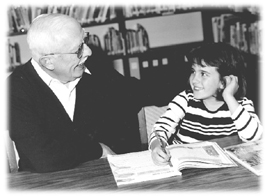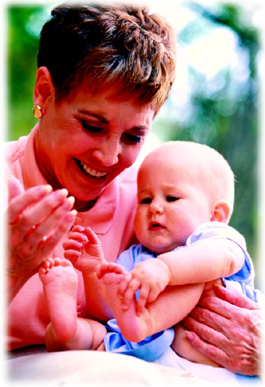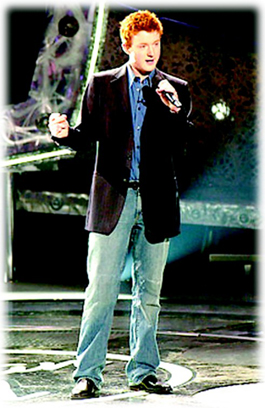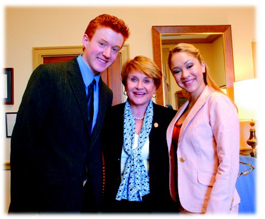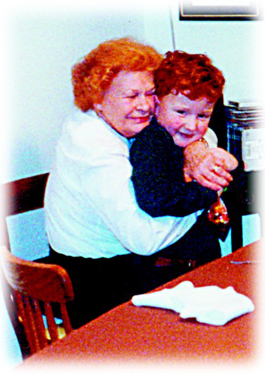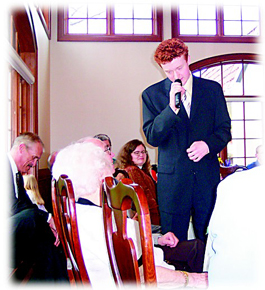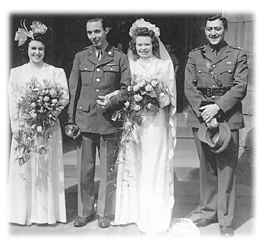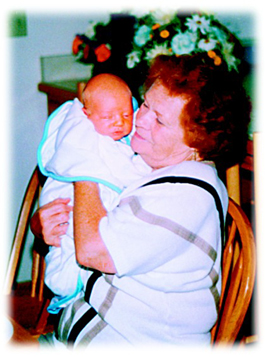
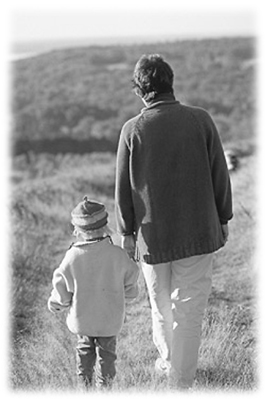
Dream Big.
By Mentoring with Love, Grandparents
Are Helping Their Grandkids Acquire
What They Need to Succeed.
by Doug Carpenter
It’s tempting to say that it “goes without saying” what a unique and invaluable contribution a grandparent’s love and support can make to the life of a child. But if you’re someone who’s had the good fortune to know one or more of your grandparents, you already appreciate why it’s so important to say it anyway. It’s the kind of thing you just don’t want to risk having go unnoticed.
A Day to Say
“Thank You” for
a Lifetime of Caring.
Fortunately, there were people who were not only enthusiastically committed to the belief that the importance of grandparenting should receive proper recognition but were willing to invest literally years of their lives doing something about it. And they did. Thanks to their efforts, we now celebrate National Grandparents Day each September on the first Sunday after Labor Day.
Officially signed into law by President Jimmy Carter in 1978, a nationwide Grandparents Day — established in September for its “autumn years” symbolism — had been the goal of a more than 10-year-long grassroots campaign. Credit for its success is shared by a number of dedicated individuals, those most prominently recognized being Marian McQuade of Oak Hill, West Virginia, Hermine Beckett-Hanna of North Syracuse, New York, and Michael Goldgar of Atlanta, Georgia.
But however appropriate and well-deserved a day honoring grandparents may have seemed back then, the intervening years — and the changes that have inevitably come with them — have only increased the holiday’s relevance and significance. One look in the mirror of our society will tell you that there’s more gray hair than ever framing the faces of America… many of them belonging to people who are now making some of the most important contributions of their lives as grandparents.
Strength, and
Responsibility,
in Numbers.
Back in 1960, a 65-year-old’s chances of living to be 90 were about 1 in 7. Today, those odds have improved to 1 in 4. What does this mean in terms of actual population? Well, as we entered the 21st century, more than 13% of Americans were at least 65, putting the membership of the 65-and-Over Club at around 35 million people.
By contrast, in 1900 that figure was just 3.1 million, showing you how dramatically things can change in a mere 100 years… which, when you think about it, really isn’t any longer than the lifetime of an actual grandparent whose life spanned that remarkable century. But it gets even better… particularly if you’re a grandparent.
If population growth projections hold true, by 2030, 70 million people — that’s 1 out of every 5 Americans — will have reached and passed age 65. Those, of course, are overall population statistics. But even when you break it down to figures specifically counting grandparents, we’re still talking some pretty impressive numbers.
No Such Thing As
Being Too Young to Be
a Grandparent Anymore.
Keeping in mind that, with the way succeeding generations have been starting families increasingly earlier, you can be a grandparent today while you’re still in your thirties. The average age of a grandparent in America is, in fact, between 49 and 53.
It shouldn’t come as a surprise, then, that currently more than a quarter of the U.S. population… some 70 million people… are grandparents. With another 75,000 or so joining them every month, the U.S. Census Bureau expects the grandparent count to climb to a whopping 117 million by the year 2010.
Looking back a century again, fewer than 50% of adolescents had two or more living grandparents in 1900. Over the next 80 years, that figure grew to almost 90%. Given advances in medicine and our increased efforts to maintain healthly lifestyles, a considerable number of those grandparents will live long enough to become great-grandparents or even great-great-grandparents.
Nobody Does It
Quite the Way
You Do.
This expanded window of time to be involved in our families’ lives means that today’s grandchildren have the greatest opportunity ever to know their grandparents for at least part of their childhood and adolescence and perhaps even their adult years. The important question, of course, is what kind of impact that will have on their lives.
Over the years, science has given us a very clear and compelling picture of the important role nurturing adults play in children’s lives. Research indicates that children need four to six involved, caring grownups in their lives for healthy emotional and social development. After the parent/child relationship, it’s the grandparent/grandchild relationship that provides the second-most important source for filling that need. The fact that this dynamic is not limited to humans shows you just how important grandparents are, regardless of your species.
University of California researchers studied a variety of different animals, including pilot whales and bottlenose dolphins, and found that these species’ grandparent generations actively participate in nurturing their extended family’s young — babysitting and even breastfeeding their grandchildren. One of the most telling observations of the study, however, was that species that invest more of their time and resources in producing new generations than in caring for them enjoy comparatively shorter life spans.
Live Long and
Prosper, Gramps.
It doesn’t take a Spock — either Dr. or Mr. — to see the obvious mutual benefits of close, interactive relationships between grandparents and grandchildren. In fact, all you have to do is ask them and they’ll be more than happy to tell you just how great it feels to be a truly involved grandparent. And that’s exactly what the University of Buffalo’s Dr. Deborah Waldrop did.
Waldrop, an Assistant Professor in UB’s School of Social Work, has made the understanding and — perhaps even more importantly — the appreciation of the aging process a major focus of her work. Her keen interest in this increasingly-important field is shared by the John A. Hartford Foundation, which made her one of a select group of Faculty Scholars across the country whose efforts it supports financially. It’s money well spent, Waldrop says, because the knowledge gained benefits young and old alike.
In the course of her research, she has conducted extensive interviews about the grandparenting experience with both women and men. The latter group, she found, were excited as well as pleasantly surprised to be asked to share their thoughts and feelings about being grandfathers.
The Difference
It Makes Goes
Both Ways.
Grandfathering, she points out, has received far
less attention than grandmothering, due in large part, she believes,
to the traditional view that women are naturally more drawn to nurturing
activities than men.
She says, however, that from the overwhelmingly-positive responses of
the men she interviewed, the contributions grandfathers make mean as much
to them as to their female counterparts.
“We asked them what role they wanted to play,” Waldrop explains, “and they told us that they wanted to be role models. To teach values. To be a good example of a strong human being.” The sentiment echoes just one of the very tangible benefits that come to both sides of the relationship when a grandparent embraces the rewarding role of mentor.
Studies show that intergenerational mentoring can contribute dramatically to the shape of a child's future, helping them develop important life skills and building their self-esteem and confidence. Researchers have found that when a child is mentored by a loving, caring adult, they’re significantly less likely to begin using alcohol or illegal drugs and far more likely to remain actively involved in getting an education.
Close relationships with their grandparents similarly affect very young children’s attitudes in unique and lasting ways. Even before they reach the age of 5, children are at risk of developing attitudes that can lead to undesirable behaviors like ageism — the stereotype-based prejudice against older people — and gerontophobia — the unhealthy fear of aging. Children who learn about aging from loving and trusted grandparents, however, are much more likely to view older people in a more positive light, and treat them accordingly.
The Shape of
Grandparenting
to Come.
Traditional grandparenting, Waldrop concedes, is rapidly giving way to new, more “actively involved and joyfully engaged” styles of grandparent-grandchild interaction, reflecting the increasingly-energetic nature of 21st century living. Whether it’s simply going on a hike or sailing off on a Disney cruise, taking grandchildren on adventures adds a whole new and decidedly non-traditional dimension to the grandparenting experience.
“What is the “traditional’ role of grandparents today?” she asks. “There’s no such thing. There’s no ‘one way’ to be a grandparent anymore when there are all kinds of new and exciting ways you can experience this important relationship. Grandparenting is very fun,” she adds. “People can and should have a good time with it.”
Not that there haven’t always been cherished moments associated with the experiences shared by grandparents and grandchildren. But the memories, of course, aren’t the only things that last. Sometimes, the effects can be permanent and life-changing. That’s something that John Stevens has experienced firsthand, and he couldn’t be happier about it.
The Kind of
Gifts That Just
Keep on Giving.
There’s a pretty good chance you know who John Stevens is. Especially if you’re one of the millions of TV viewers who’ve sat glued to their sets over the past three years following American Idol, the phenomenally-successful Fox network talent search that has turned ordinary young people with extraordinary musical gifts into household names. People like Western New York’s own favorite son in last season’s Idol competition, young Mr. Stevens.
The fact that so many people have so little trouble placing his name… and his face… and, best of all, his voice, is something for which an aspiring song stylist like John is tremendously grateful. The nice part is that he’s not the least bit hesitant to direct a large part of that appreciation precisely where he thinks it belongs. With his grandparents.
For a bright, personable young man only recently turned 18 and freshly graduated from Williamsville East High School, John’s already seen quite a bit of this country, including both coasts and a good number of places in between. He’s been to Hawaii, too, and even Europe. And the thing that provided him the opportunity to travel to all these fascinating destinations? His love of music, which he says he discovered because his grandparents shared theirs with him.
It All Began
“Over There.”
Roy and Isobel Boller could be anybody’s grandma and grandpa. Married 60 years this past April, they met when Roy’s Army Medical Corps service during the second World War posted him to a 750-bed military hospital in Glasgow, Scotland. It was the home town of a young piano teacher whose love of music would ultimately change the lives of both PFC Boller and a certain other young man they wouldn’t meet for another 44 years.
Treating the steady stream of soldiers coming into the UK from Allied convoys put Roy and the rest of the 2nd Army Evacuation Unit under tremendous pressure. But the unit’s Chaplain, recalls Roy Boller, had a cure for that. He got the men tickets to a local dance being held at the Marlborough House.
Isobel remembers finding the young American soldier charming, in spite of the fact that “he kept on complaining. About the food… the band… everything.” Apparently, however, he found the company more than reason enough to stay, and get to know the woman who 17 months later would become his bride.
After completing a tour of duty during which he cared for the wounded in tented field hospitals pitched along the Allied forces’ path to victory, Boller was finally able to be reunited with his family, which now included his first son. Bringing them to Buffalo in 1947, their first house was just up the block from his family’s corner Red & White food store at Elm and Carleton Streets, where Roswell Park Cancer Institute now stands.
Fulfilling Their
Grandparenting
Destiny.
But it would be in the Town of Tonawanda home they moved to in 1952 that they would fully experience parenthood as well as the even greater adventures that lay beyond it. For after welcoming two more children, their family continued to grow to include not just eight grandchildren, ranging in age from 18 to 31, but two great-grandchildren as well.
The 18-year-old, of course, is John, who in addition to being the youngest of the grandchildren is also the youngest of the three Stevens family children. Roy and Isobel’s daughter Lynne and her husband Jack, an Anesthesiologist, also have a daughter, Rebecca, 29, and a son, Bart, 27, both of whom have played their own unique roles in shaping their baby brother’s musical destiny. But none of his family appears to have had quite as profound and lasting an impact as his grandparents. And John is the first to acknowledge it.
As in any family, John was unavoidably immersed in the music the people he lived with listened to. His brother and sister, he says, were understandably into “modern stuff” like R.E.M. and U2, while his dad mellowed out to The Eagles or the Beatles and his mom listened to Barbra Streisand and Celine Dion. But it was a different kind of music that called to John, through the timeless sounds of legends like Frank Sinatra, Cole Porter and the Tommy Dorsey Band. And it was coming from grandma and grandpa Boller’s house.
Back When Music
Was Really Music.
To his lasting good fortune, John got to spend quite a bit of time with Roy and Isobel during his musically-formative years. Still very young, he opted to stay with his grandparents when his mom and dad accompanied brother Bart to ‘away’ games with his traveling youth hockey team, supporting a talent that eventually earned their other son the chance to play semi-professionally with the Ft. Wayne Comets.
Not that it was a tough call for John. “I had two choices when my folks went out of town with my brother,” he recalls with a wistful smile. “I could stay home with my sister Rebecca — who would make me go to bed 10 minutes before my bedtime — or go stay with my grandparents and never have a bedtime.”
He’s quick to add, of course, that Roy and Isobel didn’t spoil him. What they clearly did do, however, is provide him a loving environment in which he had the opportunity to experience things that challenged and inspired him in ways that are still enriching his life even today.
Maestro, a Little
Traveling Music Please.
While his mom, dad and brother were on their “road trips,” Roy, Isobel and their little “Johnny B” would take off on explorations of their own. Along with places like Ontario’s Butterfly Conservatory and Niagara-on-the-Lake, they also took him to performances by the Buffalo Philharmonic, further nurturing his innate love of music.
But as it so often is in life, it turned out to be the little, private moments in their relationship that would have the biggest and most lasting impact on John’s future. When they weren’t watching TV together (…having struggles for control of the channel changer which John usually won because, as he remembers fondly, “my grandmother always sided with me”…), they would listen to his grandpa’s music and reminisce.
“He would tell me stories about how he saw big bands like Tommy Dorsey and Harry James.” And then they’d play the songs that were so popular back in his grandparents’ day, because they were smooth, and hip, and cool, and made you want to sway. Music that’s still part of John to this very day, giving him the distinctive quality that carried him so impressively far into the American Idol finals and is now fueling a unique and promising career as a performer and recording artist.
And He’ll Do It
“His Way.”
Even with the special appreciation for the past that John has developed through his extraordinarily close relationship with his grandparents, he’s clearly not interested in living in his. For all the glamour that came with being in the national spotlight through Idol, he’s actively building a future for himself in which to enjoy and expand the gifts that have been given to him.
His first CD, Red, is now in stores, and he and his band are looking forward to recording more. For the present, though, he’ll be taking his act on the road to higher education this January when he enrolls in Boston’s prestigious Berklee College of Music, which proudly claims alumni ranging from Quincy Jones and Diana Krall to Bruce Hornsby and Melissa Etheridge. Proof if you ever needed it that songbirds of a feather really do flock together.
After that? Concerts. Perhaps television or films. Maybe even Broadway. And almost certainly more fame, something John admits he’s found both flattering and, at times, a little overwhelming. But it’s his performance as a person that has particularly impressed his grandma Isobel, who probably should know a thing or two about fame herself, who along with husband Roy was paid tribute to on national television by her very grateful grandson.
Grace Under Fire
Runs in the Family.
In a voice still rich with the burr of her Scottish roots, Isobel describes John with classic grandmotherly pride. “John is an extraordinary young man. He has so many gifts,” not the least of which, she adds, “is the gift of being himself,” something he’s managed to do even through the kind of life experiences that could easily change the most secure and seasoned adult… not necessarily for the better.
But as Lynne Stevens wisely points out, how could he not? He had a grandfather who stood tall as he bravely cared for the fallen in the heart of World War II. And a grandmother who had the courage to cross an ocean and start a whole, new life in a foreign land. So when — out of the more than 70,000 who auditioned nationwide — John made it all the way to American Idol’s top 12, his family was most certainly proud… but hardly surprised.
And though his grandmother may still be “amazed at how well he’s handling it all,” when she wonders aloud where he gets the strength, one need only look to the unqualified love and encouragement he gets from his family… especially his grandparents… to know the answer to that question.
© 2005 Doug Carpenter
